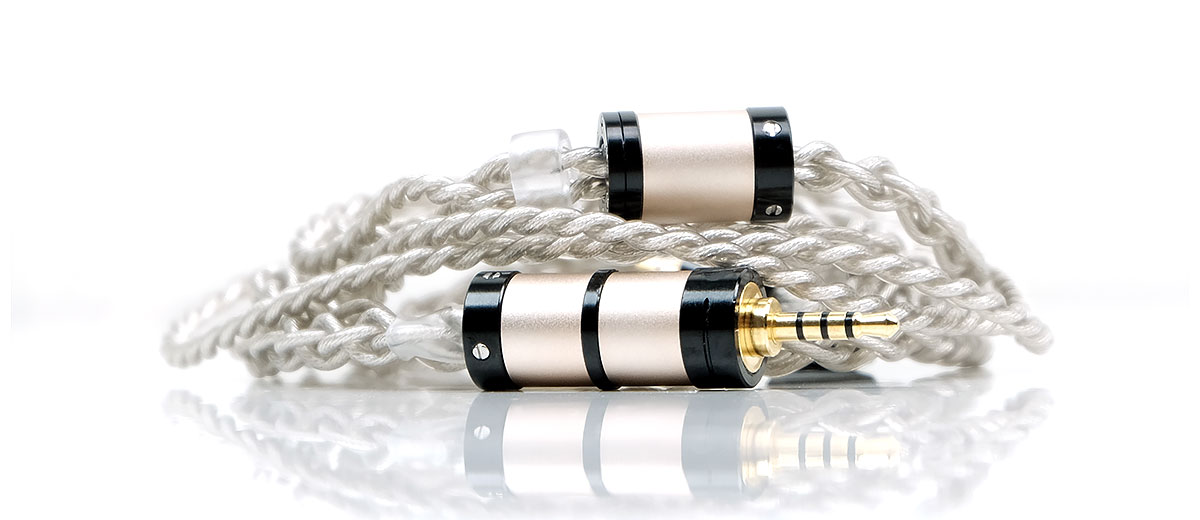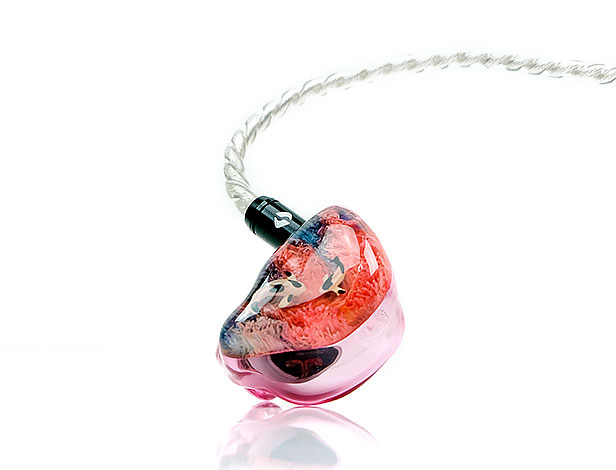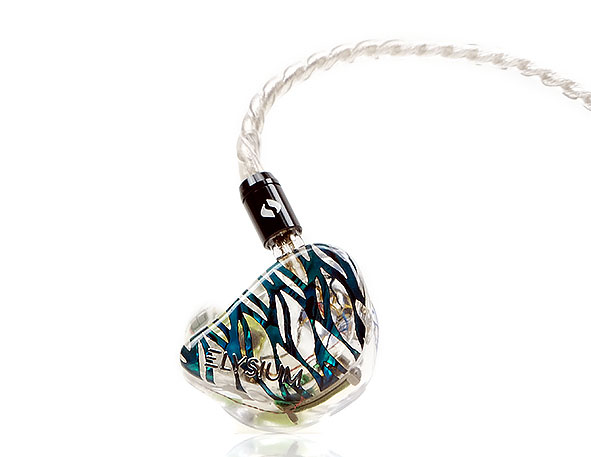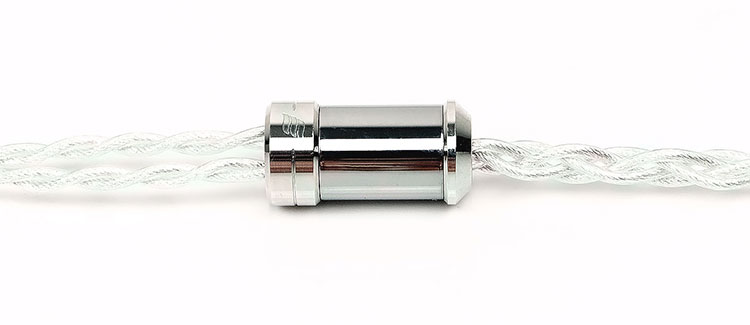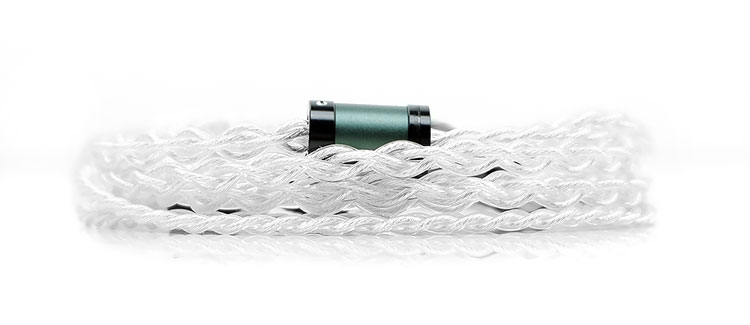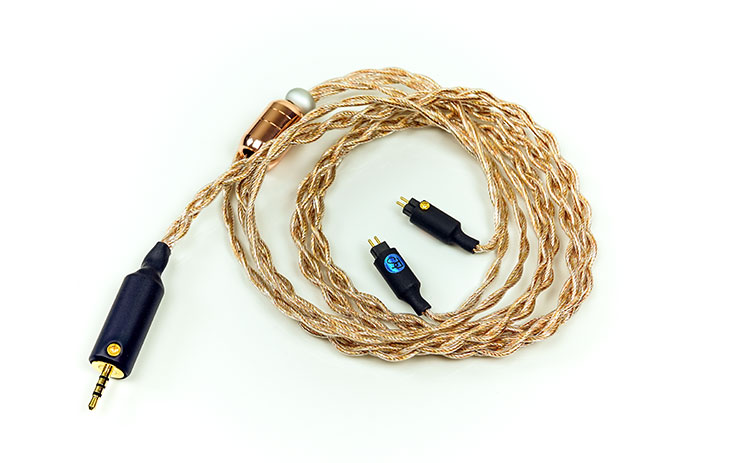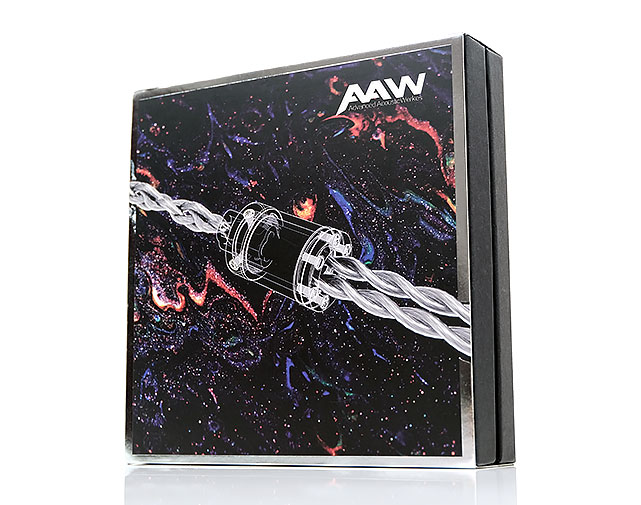Aoraki Performance Impressions
Summary
No question the Aoraki is a basshead cable with a low-end even more powerful sounding than Effect Audio’s Cleopatra which goes for roughly the same price. In fact, it makes it sound reasonably neutral which takes some doing.
However, that is not at the cost of clarity because the dynamic range and level of instrumental separation are very good indeed. I would expect that with a 24AWG good quality wire and it does have a slight edge compared to some of the 26AWG 4-wire variants we compared it to.
What you will find though is a shade more wetness into the upper treble of most of the monitors we hooked up to the Aoraki. Not enough to cloud any core monitor sound but more of a relaxing lilt to the timbre balance. That is pretty much a running theme for the Aoraki pairing – smooth, relaxing on the top-end, rich, and powerful on the low-end.
For example, AAW’s Thera 24AWG silver composition is very clean in the mids and treble, especially with the Da Vinci X so any bright mixes will show up immediately with natural sibilance easily detected.
Here the Aoraki smoothes that out a shade adding a bit more girth and richness to deliver a wetter sweet sound but at the same time retains a very healthy level of separation so it is not even close to sounding lush or veiled.
Timbre
Most of that richer and powerful timbre is amplified if you hook the Aoraki up to a dynamic driver monitor, particularly ones with a stronger bass response like the Fusion.
We tested the ItsFitLabs Fusion and found the degree of change in response of the dynamic driver to be much more radical than the 10 BA driver tuning of the CTM Da Vinci which is inherently reference-like, to begin with.
The Aoraki does deliver a slightly smoother midrange and more power on the Da Vinci X, but not as transformative as the Fusion which sounded very deep and very nicely separated also.
If there is one area though that does differ from a traditional silver cable like the Thera or the Cleopatra to a lesser extent is the amount of treble shining through and how it shines through.
I find the treble on the Aoraki to allow for an excellent level of body and a very refined tone but it is not a bright or aggressive sound. I suspect that the mix of gold and palladium in the wire alloy just attenuates the silver wire from producing too much sibilance on female vocal timbre so it stays smooth but not lush or veiled.
Staging
The Aoraki’s dynamic range and low-end extension produces a tremendously powerful and deep sound stage. Again, dynamic driver IEMs seem to lap it up more and respond better than BA drivers though they are not without some enhancements.
Height is a shade attenuated but interestingly width and separation are not with our tested monitors so it retains a complex and wide staging element. Compared to a 26AWG variant such as PLUSSOUND’s Tri-Copper you might hear a bit more separation and a wider imaging field, particularly on how open the mids sound despite the softer treble tilt.
It doesn’t quite have the speed and tightness of the Thera but the Thera (Halcyon packaged but $399 separate) is more linear and more mids to treble in terms of height with less depth and power.
Synergy
It is not that I found the Aoraki to not mesh well with all BA driver monitors but rather dynamic driver low-ends responded in a more powerful manner. As mentioned we tested with the CTM Da Vinci X, ItFitsLab Fusion, and also the Vision Ears Elysium, and of the three it was really the Fusion’s colored and strong bass tuning that benefitted the most.
The slam on this driver combined with the Aoraki was pure poison, to put it mildly, and almost on power with some of my favorite 8-wire basshead cables such as the OC Studio Orpheus MK5.
The bloom was also kept under control really well with more of a sub-bass focus than a punchy mid-bass delivery. The punchy mid-bass delivery was more prevalent on the Thera which tends to thin out the weight more than the Aoraki and rob the Fusion of its signature power in favor of a cleaner tone.
However, it was not without its charm with BA monitors, and in some cases, it does add some healthy weight to the low-end, particularly if the low-end BA driver is one of the bigger subwoofer versions.
For example, the Vision Ears Elysium sounded more planted than the stock cable on its BA driver’s low-end when paired with the Aoraki. Compared to AWW’s silver 24AWG Thera it was certainly a lot weightier but also that mids dynamic driver had a bit more thickness to it also.
The 5-BA driver Empire Ears Phantom is another case in point. It uses the stock Effect Audio Ares II cable which is a very strong step-up from stock P1 cables but it is mildly linear and neutral in low-end power compared to the Aoraki.
Both are 4-wire but the higher gauge rating of the Aoraki does deliver a bit more dynamic range and a wider soundstage as a result. And yes, more power on the low-end as you might expect from reading this review thus far.
The only caveat from this pairing is the level of warmth and low-end dominance. If you prefer something cleaner and more neutral, and some do with the Phantom, then I would go with the Thera from AAW instead as it tones down the bass body just a shade.
Select Comparisons
For the comparisons, we selected a fairly reference sounding source, the Lotoo PAW Gold Touch and 2 monitors; one reference, the Clear Tune Monitor’s Da Vinci X. and one fun-sounding, the ItsfitLabs Fusion.
Effect Audio Cleopatra
$699
Technical
The Cleopatra is also priced at $699 and in my eyes, would be a solid competitor if you are shopping at this price point. This is also a 1.2mm cable from their Heritage Series that can come in 4 or 8-wire but the mix of materials is very different.
First, the gauge on the Cleopatra 4-wire is smaller at 26AWG compared to the 24AWG of the Aoraki. The 26AWG will provide a little more resistance so long as the purity of the wire is of the same level of quality.
Second, the wire is UP-OCC Pure Silver high purity pure silver as opposed to the complex gold, silver, and palladium alloy of the Aoraki. Having said that, the silver in the Aoraki is also UP-OCC grade.
Both cables are Litz builds though Effect Audio does not state any specific type other than to say it has a 7-core geometry and the stands are individually enameled individually in a woven Litz technique.
The Aoraki is a Litz wire Type 5 so there is a bit more knowledge about the structure. Note the Aoraki uses a platinum core compared to the Kevlar core of the Cleopatra. The platinum core is more about flavoring the signature whereas the Kevlar core of the Cleopatra is about strengthening the build.
Design
Because of the heavier gauge, the Aoraki is a shade heavier and thicker than the Cleopatra but not by a huge amount. AAW has kept the braiding quite dense and tight to limit the Aoraki ‘girth’. Both handle immaculately but the Aoraki has a shade less memory retention and a bit quieter also for microphonics.
Aesthetically I find both cables to be equally as good as each other but they do look quite different with the Cleopatra having much more of a silver sheen compared to the more muted grey-gold of the Aoraki.
Both have complementary but very different barrels with the faded-gold anodized CNC machines aluminum of the Aoraki and the silver chrome barrel finish of the Cleopatra. The chrome barrels of the Cleopatra are heavier which is one reason behind the same feel in terms of weighting despite the Aoraki being a heavier wire.
Both have similar compact connectors with plenty of termination options for both jack and connector. One thing to note is the use of PSquared jacks on the Cleopatra which the Aoraki does not use. It uses a more exotic blend of palladium and platinum materials compared to rhodium or gold-plating.
Performance
Both are aiming for a smooth delivery but there are some differences. Initially, when paired with the reference CTM Da Vinci X I felt the dynamic range between the two was almost the same.
The tone is different though with the Aoraki offering a generally warmer overtone from the X with the Cleopatra teasing out a bit more mids and treble neutrality courtesy of that pure silver wire inside.
However, once you throw in a harder-hitting dynamic driver hybrid into the mix or the Fusion in this case, it becomes clearer that the Aoraki has an edge in terms of low-end dynamic range and power.
I do not mean just more weight but also improved layering and separation. The Aoraki will bring out a bit more sub-bass extension and volume from the Fusion compared to the Cleopatra’s but it also sounds a bit more defined and impactful.
From the upper mids and treble onwards the Cleopatra offers a little bit more of a lift compared to the wetter Aoraki but not as much dynamic range, especially with the Fusion. The Aoraki has a solidity to its upper mids and lower-treble performance, particularly for percussion with excellent separation and a pure ‘strike’ with plenty of air.
The Cleopatra is just a shade less distinct in its separation but extends a little bit more for upper treble presence. That means a marginally taller staging element compared to the deeper and more expansive sounding Aoraki.
AAW Thera
$399
Technical
The Thera can be bought independently or with the new Halcyon hybrid electrostatic monitor. It is a good deal cheaper but it does share some common properties with the Aoraki. The price difference is primarily around the choice of materials as both use 24AWG wires inside a PVD deposited clear coating jacket.
The Thera is a 1.2m UP-OCC Cryo-silver Litz Type 5 wire with a 10% silver solder finish and 24k gold-plated pin contacts. The Aoraki also uses a silver solder finish with 24k gold-plated contacts and a Type 5 Litz geometry. However, the wire is a more exotic and complex UP-OCC cryo-silver mixed with gold and palladium and using a platinum core for a bit more “sound flavoring”.
Design
Both cables handle equally well due to the consistency of the same pliant PVD coated jacket as well as the same braiding technique. The only key difference is the aesthetical tone due to the internal wire. The Thera is very bright and silvery looking whereas the Aoraki is a dark grey-gold tone.
They also use the same anodized CNC machined lightweight splitter and jack barrels though the Thera we have here uses the green finish as opposed to the faded-gold finish of the Aoraki sample. Primarily due to the packaging with the green finish of the Halcyon. It may be possible to change to a different color as well picking from a multiple range of terminations at either end.
Give the matching design properties and jacket it will come as no surprise that both have the exact same handling impressions with next to know memory retention and very low levels of microphonics. The two cables also have that soft and supple memory coating at the top-end that makes them a joy to wear despite being a heavier 24AWG wire.
Performance
The Thera is more of a classic silver wire tuning whereas the Aoraki fattens up the timbre and added more additional low-end warmth and power. Since both are 24AWg cables there is no difference in dynamic range so you will not find yourself adjusting for volume between these two cables.
Overall, the Thera is much more neutral but it is quite tight also. On both the Da Vinci X and Fusion the low-end was punchy but not voluminous which does help create a bit more space for the mids and treble to shine. The Aoraki goes much deeper, with more sub-bass presence, particularly allowing the Fusion dynamic driver to shine.
Timbre is clean on the Thera, particularly on the upper mids and lower treble of the Fusion. Might be a shade too clean and neutral on the Da Vinci X but for those who like a more analytical and pacy articulate sound then it is a good match. It does help tame down the Fusion strong low-end a little and produce a nicely balanced but musical flavor.
The Aoraki allows for a richer and slightly sweeter timbre, particularly vocals and percussion but a shade more natural and smooth sounding. The treble performance on both monitors is not quite as forward as the Thera which might suit those who are averse to natural sibilance.
Overall, the Aoraki will pull you to the low-end power and richer mids whereas the Thera is brighter, a bit cleaner, and more mids to treble in terms of energy and focus.
PLUSSOUND Tri-Copper
$549
Technical
The Tri-copper comes in slightly cheaper than the Aoraki but delivers a very different geometry and material composition.
This time it is all copper, or three types of copper to be precise: UP-OCC copper, silver-plated copper, and gold-plated copper all in a 4-wire, 6-wire, or 8-wire 26AWG build. This is quite a contrast to the AAW Aoraki that has a blended mix of UP-OCC silver, gold, and palladium all in a larger 24AWG platinum core 4-wire or 8-wire construction.
Both are Litz builds but use different geometries. The Tri-copper is a Litz Type 6 construction that features bundles of type-4 wire twisted around a fiber core. The Aoraki uses a Type 5 Litz build featuring bundles of type-2 wire twisted around a fiber core.
Design
They look very different, partly due to the difference wire inside but also due to the finishing and design from each company. Note, both companies offer a very wide range of connectors, barrels, and jacks so the ones I am talking about here are not fixed in stone. For example, you can get much lighter barrels such as wood for PLUSSSOUND or heavy XLR jacks for the Aoraki.
The Tri-Copper is very much a copper tone color and for this sample, its complemented by rose-gold chrome barrels and the black with rose-gold labels jack barrels and connectors. The Aoraki has a softer grey-gold color complimented by lighter and smaller faded-gold anodized CNC aluminum barrels and jack.
The connectors on the PLUSSOUND are excellent. Even if slightly bigger they screw lock which I prefer over glue finishing. This edition uses the older DIY vide connectors, the new versions of the Tri-Copper editions will have more professionally finished jacks and barrels but still the same screw lock.
The Aoraki does have a better braid technique so despite being a larger 24AWG wire it feels smaller in the hand. The PLUSSOUND braiding on this sample is looser with a longer throw so the girth is naturally a bit wider than the tighter short-throw braid of the Aoraki.
Both have good quality soft insulation jackets so they are very pliant but that longer throw of the Tri-Copper makes it a little stiffer for handling, (bending). The Aoraki’s braiding and jacket are also marginally lower in microphonics during handling compared to the Tri-copper.
Performance
There is a big difference between these two cables and it focuses primarily on the dynamic range, staging width, and low-end power. The timbre on these two is a little on the similar side with a hue of warmth permeating throughout and nothing too strident on the treble.
Both the dynamic range and low-end power are close companions so whilst the Tri-copper is a rich and fulsome sounding on the Fusion, it did not have that same explosive power when paired with the Aoraki.
Vocals also might be perceived as having a better presence on the Fusion and Da Vinci X with the Aoraki compared to the Tri-copper. I think again that goes back to better dynamic range and you do get a sense of enhanced separation and a blacker background as a result with the Aoraki.
Combined those elements together and you also get a more complex soundstage, particularly in the mids which sound a fair bit wider and more vivid on the Aoraki/Fusion combo. The Tri-copper sounds a little more centered focused by comparison.
Our Verdict
The AAW Aoraki is a beautifully made monitor cable but more importantly, it produces a very distinct tweak on IEMs, particularly those with dynamic drivers that can roar when pushed.
This is a cable bassheads will enjoy or those looking for more power but maybe slightly sensitive to any additional treble overload when dynamics are upped to the next level. At the same time, details are not overlooked but rather delivered in a natural smooth manner, even with reference IEMs.
If you prefer your sound clean, neutral, or super articulate this may not be the right cable for you, the AAW Thera at $399 will give plenty of that. The Aoraki is more about power where a monitor can deliver it and a richer smoother timbre with the right pairing.
AAW Aoraki Specifications
- Cryogenic treated monocrystalline silver/gold/palladium conductor with pure platinum core, UPOCC cast.
- Wiring Color: Silver/Translucent Grey
- Wiring: 24AWGHardware: Symphonym Chrono Anodized Series
- Length: 1.2m or 48″ (Contact for customization)
- Solder: NA Custom 10% Silver Solder
- Pin contact: High Precision Fabrication, 24k gold plated




